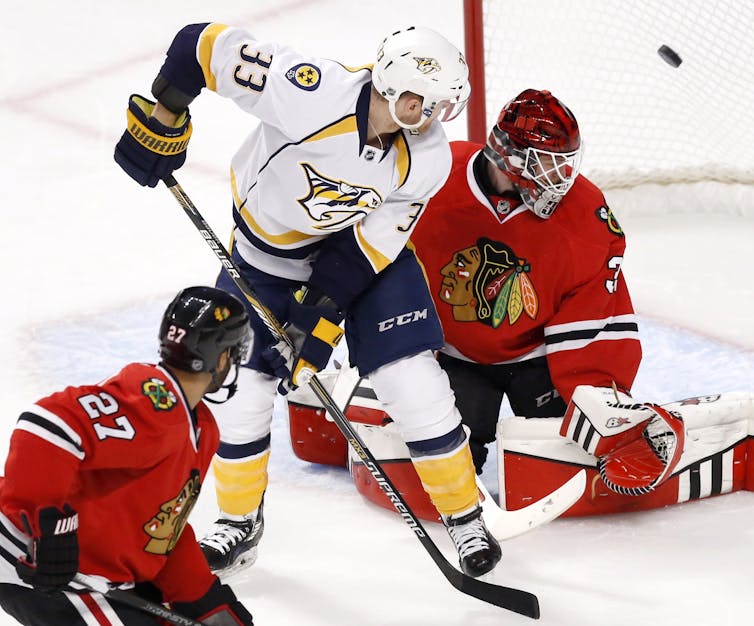The luck of the puck in the Stanley Cup – why chance plays such a big role in hockey

A mathematical approach known as 'true score theory' can assess the contribution of luck to a team’s overall success. Bruce Bennett/Getty Images
The NHL playoffs are almost like a second season – two months of bruising, relentless play, as the top teams compete for the chance to hoist Lord Stanley’s Cup.
The 16 hockey teams that have made it into the postseason owe a great deal of their success to the abilities of their players and the tactics of their coaching staffs.
They should also thank their lucky stars.
In my new book “The Random Factor,” I explain why of the five major U.S. team sports – basketball, football, baseball, hockey and soccer – the one with the greatest amount of luck involved in wins and losses is hockey.
Skill vs. chance
Using a mathematical approach known as “true score theory,” analysts have been able to assess the contribution of luck to a team’s overall success.
This statistical technique utilizes the variance in skill, chance and outcome to estimate the relative importance of skills versus chance in determining results.
In the NHL, it is estimated that the contribution of luck to a team’s season record is approximately 53%. At the other end of the spectrum, only 12% of an NBA team’s record is due to luck.
The other three sports are clustered in the middle, with their position in the standings influenced roughly one-third by luck.
More scoring opportunities matter
How might these differences be understood?
One key factor is the number of opportunities that a team has to score. The more chances a team has, the less luck plays a role in the outcome.
In a typical NBA game, each team may tally 35 or more baskets during a game, whereas in an NHL game there may be only one or two times that a team scores. Luck plays much more of a role when the opportunities to score are lower. In these situations, a lucky bounce is more likely to determine the outcome of a game.
You can see this with coin flips. If you flip a coin 10 times, you may very well wind up with seven or eight heads or tails, even though the overall probability on any individual coin toss is 50%. With so few tosses, there can be significant deviations from what should theoretically happen: five heads and five tails.
However, if you flip a coin 100 times, you’ll probably find that nearly half of those coin tosses will be heads. As the number of events – in this case, coin flips – increases, the more likely the final tally will reflect the underlying probability.
Similarly, in sports, the abilities of players are more likely to come to the fore when there are more opportunities to score. In the NBA, a player can attempt more than 20 shots over the course of a game – perhaps making half of them – so they have more chances to put their skills on display and influence the outcome of a game.
Deflect, deflect, deflect
The outsize role of luck in hockey can also be explained by an additional factor.
While scoring in typical NHL games is quite low, each team may very well attempt 45 or 50 shots. This would seemingly refute the explanation that the number of events or opportunities influences the role of luck in a game’s outcome.
Yet anyone who has ever watched a professional hockey game can grasp the randomness that’s taking place on the ice. Skates or sticks often randomly deflect shots when players cross in the path of a puck’s trajectory. Pucks can take strange bounces as they travel across the rink. Goalies might just happen to be in the right place at the right time.

Nashville Predators center Colin Wilson (33) watches his deflection of a shot fly past Chicago Blackhawks goalie Scott Darling during a playoff game in 2015.
AP Photo/Charles Rex Arbogast
In short, there is considerable randomness that occurs between the time the hockey stick hits the puck and where it eventually ends up.
It’s also simply difficult to score a goal in hockey. The net is small and the goalies are large and wear bulky pads. Pucks have very little space to squirt through.
Across all sports, chance and luck add excitement and intrigue to these contests. You can never be quite sure of the way the ball or puck may bounce. While your team may be heavily favored, the random factor is always in play.
Nowhere is this more apparent than in hockey.
So for all of the predictions from pundits and oddsmakers, fans of NHL playoff teams would be wise to do something else: cross their fingers.
![]()
Mark Robert Rank does not work for, consult, own shares in or receive funding from any company or organization that would benefit from this article, and has disclosed no relevant affiliations beyond their academic appointment.






